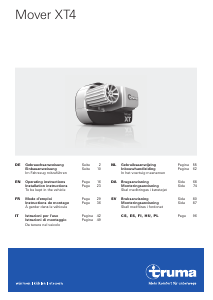
13
Connecting the engagement motors
The positive connection (r) of the 2-wire motor connection
cables has been marked with a red longitudinal line along the
cable insulation.
Mark motor cables A + B and route to control unit (shorten
cables to same length if necessary).
Slide spade connector sleeve insulation over the cables
(e.g. black for motor A and transparent for motor B). Crimp on
spade connector sleeves, slide on spade connector sleeve
insulation and connect as shown in connecting diagram.
Installing the isolating switch
Install isolating switch in a suitable location (near the battery)
in the positive lead between the battery and the controller.
– A hole with a diameter of 25 mm is required for installation.
– Turn key anticlockwise until it reaches the end position and
remove.
– Slide isolating switch through hole and secure with
either the provided chipboard screws (5 x 16 mm) or the
M6 x 30 bolts and M6 self-locking nuts.
– Cut the positive lead of the battery and crimp the provided
pipe-type cable shoes to both ends of the cut cable.
– Insert key again and move to “OFF”. Screw cable with
pipe-type cable shoes to isolating switch. Connecting order:
Pipe-type cable shoe, spring washer, nut.
+ Battery
ON
take out /
insert key
OFF
+ Control unit
Ø 25 mm
Fig. 33
Connect battery connecting cables to the existing battery
terminals (red = positive, black = negative).
The connection to the control unit (as per the connecting diagram)
must take place in the order – nut, battery connection ring, nut.
Connecting the battery
Liquid electrolyte batteries need to be placed in a separate
box with an external venting system. The fuse for the positive
line needs to be connected outside the box. The gel and AGM
batteries do not need a separate box. Observe the installation
regulations of the battery manufacturer.
The cables leaving the terminal need to be installed separately
from each other until after the fuse in the plus line.
+
-
+
-
Fig. 34
Route battery connecting cables (only use the original Truma
cables included in the delivery) to control unit and securely
attach using the provided clips and screws.
The battery connecting cables must not be extended.
They must be routed separately from the motor cables,
and must not run over the control unit.
Route battery connecting cables so that they do not chafe
(particularly at leadthroughs through metal panels). Use suit-
able leadthrough grommets for protection in order to prevent
damage to cables. Connect battery connecting cables to the
existing battery terminals (red = positive, black = negative).
Incorrect wiring will destroy the electronics / control
system.
The connection to the control unit (as per the connecting dia-
gram) must take place in the order – nut, battery connection
ring, nut (torque 7 Nm ±1).
Connect the fuse in the positive cable (150 A) close to the
positive contact.
Wiring of the safety socket with the micro switch
Guide the enclosed 2-wire cable with the flat connector
through the socket holder (g) and the rubber coupling (h).
If necessary, open the cover and press the socket connection
out of the socket housing (i).
Insert the 2-wire cable with the flat connector into the micro
switch.
RD / BK
BK
Fig. 35
If necessary, reinsert the socket connection into the socket
housing (i).
Screw socket housing (i) to socket holder (g) using 3 sheet
metal screws (j). (Several alternative positions are available by
using the mounting holes in the socket holder and rotating the
rubber seal).
Loosely route cable through strain relief (k) and secure with
2 sheet metal screws. Depending on the installation situation,
the cable can be led out of the socket holder through one of
the three recesses.












Praat mee over dit product
Laat hier weten wat jij vindt van de Truma Trumove T Caravanmover. Als je een vraag hebt, lees dan eerst zorgvuldig de handleiding door. Een handleiding aanvragen kan via ons contactformulier.